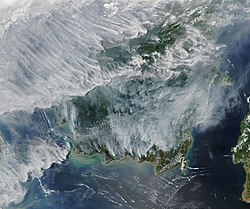|
Air Pollution Index
MalaysiaThe air quality in Malaysia is reported as the API (Air Pollutant Index) or in Malay as IPU (Indeks Pencemaran Udara). Four of the index's pollutant components (i.e., carbon monoxide, ozone, nitrogen dioxide and sulfur dioxide) are reported in ppmv but PM2.5 particulate matter is reported in μg/m3.[3] This scale below shows the Health classifications used by the Malaysian government.
If the API exceeds 500, a state of emergency is declared in the reporting area. Usually, this means that non-essential government services are suspended, and all ports in the affected area are closed. There may also be a prohibition on private sector commercial and industrial activities in the reporting area excluding the food sector. Former indicesChinaChina's State Environment Protection Agency (SEPA) is responsible for measuring the level of air pollution in China. As of 28 August 2008, SEPA monitored daily pollution level in 86 of its major cities. The AQI level was based on the level of five atmospheric pollutants, namely sulfur dioxide (SO2), nitrogen dioxide (NO2), suspended particulates (PM10), carbon monoxide (CO), and ozone (O3), measured at the monitoring stations throughout each city.[4] AQI Mechanics The scale for each pollutant is non-linear, as is the final AQI score. Thus an AQI of 100 does not mean twice the pollution of AQI at 50, nor does it mean twice as harmful. While an AQI of 50 from day 1 to 182 and AQI of 100 from day 183 to 365 does provide an annual average of 75, it does not mean the pollution is acceptable even if the benchmark of 100 is deemed safe. This is because the benchmark is a 24-hour target. The annual average must match against the annual target. It is entirely possible to have safe air every day of the year but still fail the annual pollution benchmark.[4] AQI and Health Implications (Daily Targets)[4]
Hong KongThe API was in use in Hong Kong from June 1995 to December 2013. It was measured and updated hourly by the Environmental Protection Department (EPD). Moreover, the EPD made forecasts of the API for the following day every day. The API was based on the level of six atmospheric pollutants, namely sulphur dioxide (SO2), nitrogen dioxide (NO2), respirable suspended particulates, carbon monoxide (CO), ozone (O3), and lead (Pb), measured at all the monitoring stations throughout the territory.[5] It was replaced by the Air Quality Health Index on 30 December 2013. There are 11 General Stations and 3 Roadside Stations. The former includes Central / Western, Eastern, Kwai Chung, Kwun Tong, Sha Tin, Sham Shui Po, Tai Po, Tap Mun, Tsuen Wan, Tung Chung, and Yuen Long; the latter Causeway Bay, Central, and Mong Kok.[6] In Hong Kong, there were two types of API: General API and Roadside API. The EPD reported the latest APIs hourly. The index and the air quality objectives were set in 1987; and pollutant levels are measured over varying periods, in μg/m3. There are hourly, 24-hour and annual targets for sulfur dioxide and nitrogen dioxide, and 24-hour and annual targets for particulates. The table below shows the official Health Implications of the respective AQHI levels in Hong Kong.
In 1998, the Education Bureau's recommended schools to curtail outdoor activities when the index reached 200, whereas leading healthcare advocates are urging that the level be revised to 100.[7] The World Health Organization revised its air quality guideline levels of sulfur dioxide, nitrogen dioxide and ozone in 2006 in light of new scientific evidence. The WHO also introduced new measurement guidelines for very small particulates which are more dangerous to pulmonary function. At the '200' level, Hong Kong levels of SO2 (800μg/m3) and NO2 (1,130μg/m3) are 40 times and 5½ times WHO guidelines respectively; the equivalent for particulates (350μg/m3) is 7 times WHO guidelines.[5] See also
References
External links |
